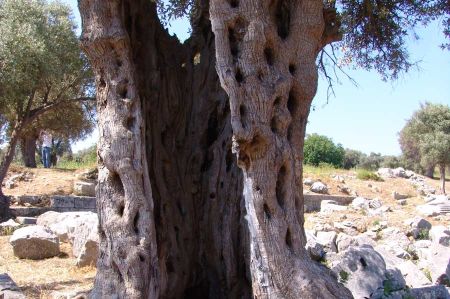Olive trees - cultural-historical examination of the olive tree
- Written by Portal Editor
During our return journey from Istanbul via the Dardanelles towards Izmir, we also passed the region around the tourist town of Ayvalik. Like almost everywhere in Turkey, the construction industry is booming here and this is why there is often serious clear-cutting in nature, even if it "only" consists of huge groves of thousands of olive trees.
Ayvalik is one of the centres of Turkish olive plantations, famous for excellent quality virgin olive oil, which is so healthy due to its ingredients. Most of the groves still exist, covering areas up to the horizon and drawing the eye to the always green, sometimes ancient trees as you drive past.
Olive trees that are well over 9,000 years old
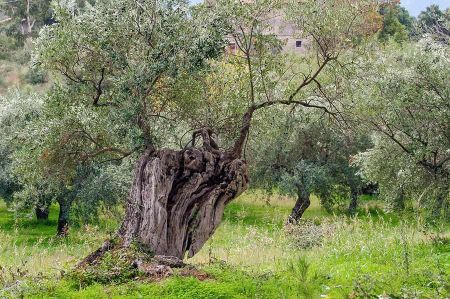 The cultural history of the olive, also known as the olive tree, goes back far into antiquity; the age of some trees alone is many centuries, as can be quickly and easily proven by the gnarled trunks. Archaeological excavations have revealed olive pits that are well over 9,000 years old. Of course, these are wild olive fruits, because at that time agricultural cultivation was not yet known and the people at that time were mainly gatherers and hunters. Wild olives grew widely along the coasts of the Mediterranean. When olive trees were first cultivated as crops is still a matter of scientific debate. It is believed that olive trees were first cultivated for use on Crete, but especially in Syria, around 4,000 BC. The Israelites who then immigrated found the olive tree already there. Kings David and Solomon encouraged its cultivation. The oil was used in food, in sacrifices, as fuel and to anoint the hair and the entire human body.
The cultural history of the olive, also known as the olive tree, goes back far into antiquity; the age of some trees alone is many centuries, as can be quickly and easily proven by the gnarled trunks. Archaeological excavations have revealed olive pits that are well over 9,000 years old. Of course, these are wild olive fruits, because at that time agricultural cultivation was not yet known and the people at that time were mainly gatherers and hunters. Wild olives grew widely along the coasts of the Mediterranean. When olive trees were first cultivated as crops is still a matter of scientific debate. It is believed that olive trees were first cultivated for use on Crete, but especially in Syria, around 4,000 BC. The Israelites who then immigrated found the olive tree already there. Kings David and Solomon encouraged its cultivation. The oil was used in food, in sacrifices, as fuel and to anoint the hair and the entire human body.
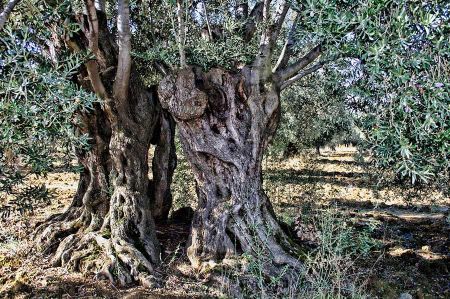 There are numerous references to the use of the tree and its fruits in the records of early ancient times. From Homer's stories in the Iliad, we know that olive oil was used to anoint the body, but this was reserved for the "upper class":
There are numerous references to the use of the tree and its fruits in the records of early ancient times. From Homer's stories in the Iliad, we know that olive oil was used to anoint the body, but this was reserved for the "upper class":
“But Atreid, drawing his sword full of silver humps, jumped up to Peisandros. He raised the shining battle-axe under his shield, the honourable one, adorned with the handle of an olive tree, beautifully smoothed and long; and they pressed against each other at the same time.”
(Homer: Iliad, Canto 13, 610–613)
“Within the enclosure there was an olive tree that shaded widely, strong and blooming; the trunk resembled pillars in thickness. I built it all around it with densely arranged stones, our marriage chamber, and arched the upper ceiling and closed the gate with tightly fitting wings. Then I cut off the branches of the olive tree that shaded me far and hewed the trunk at the root, smoothing it artificially and beautifully all around with the bronze and according to the measure of the rule; carved it at the foot of the bed, and drilled it all around with the drill, added planks to it, and built the graceful bed, which was decorated with gold and silver and ivory and ran through it with straps of purple bull skin.
(Odyssey, Canto 23, 190–201)
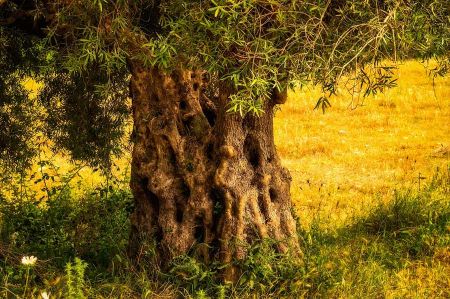 However, Homer's descriptions focus more on the wood of the olive, which, due to its strength, was used to make handles for tools and axes. According to Greek legend, the gods Athena and Poseidon once had a competition. The winner should be the one who delivers the more meaningful gift to the people of Athens. Athena prevailed with the olive tree she created, which was considered sacred by the ancient Greeks. In many Greek city-states at the time, it was even illegal to cut down olive trees.
However, Homer's descriptions focus more on the wood of the olive, which, due to its strength, was used to make handles for tools and axes. According to Greek legend, the gods Athena and Poseidon once had a competition. The winner should be the one who delivers the more meaningful gift to the people of Athens. Athena prevailed with the olive tree she created, which was considered sacred by the ancient Greeks. In many Greek city-states at the time, it was even illegal to cut down olive trees.
The mentions in the Bible also point to the great importance of the olive tree:
“Once upon a time the trees arose to anoint themselves a king, and they said to the olive tree, 'Be our king.' The olive tree said to them, 'Shall I give up my fat, which is used to honor gods and men, and go 'to sway above the other trees?'” (Book of Judges, 9:8-9)
“Towards evening the dove came back to him, and lo and behold, it had a fresh olive branch in its beak. Now Noah knew that there was little water left on the earth.” (Genesis, 8, 11)
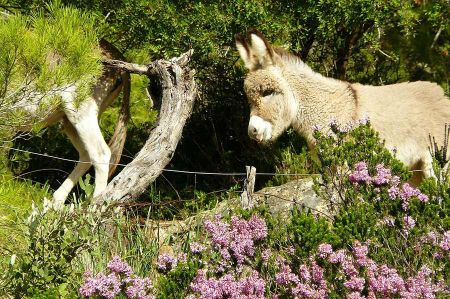 “But even though some of the branches have broken off, and you, being a wild olive tree, have grafted among them and become partakers of the root and the juice of the olive tree, do not boast against the branches. But if you boast about them again, you should know that you do not support the root, but the root supports you." (Romans 11:17-18)
“But even though some of the branches have broken off, and you, being a wild olive tree, have grafted among them and become partakers of the root and the juice of the olive tree, do not boast against the branches. But if you boast about them again, you should know that you do not support the root, but the root supports you." (Romans 11:17-18)
There are also comparable, interpretable records of the importance of the olive tree in the Koran:
“And it is He who sends water down from heaven; with it we produce all kinds of plants; … and olive and pomegranate (trees) …” (The approximate meaning of Al-Qur’an Al-Karim, Sura 6:99 “The Cattle”).
“Allah is the Light of the heavens and the earth. Its light is like a niche in which there is a lamp: The lamp... Lighted (the lamp is) by a blessed olive tree, which is neither east nor west, whose oil would almost glow even if the fire did not touch it. (The approximate meaning of Al-Qur'an Al-Karim, Sura 24:35 "The Light").
“Then We divided the earth miraculously and caused corn to grow in it... and olive trees...” (The approximate meaning of Al-Qur'an Al-Karim, Sura 80:26-29 "He frowned").
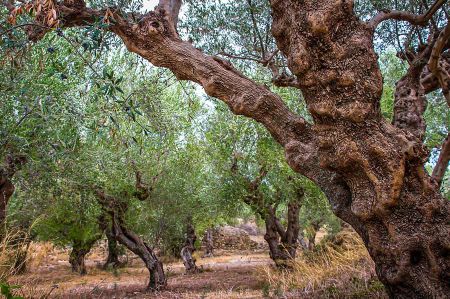 Even these few text excerpts clearly show the importance of the olive tree. In the dry climate of the Middle East, olive oil soon became an important and healthy staple food and therefore also became an important economic factor. The oil fruit formed a significant part of the wealth and, along with the fig tree and vine, became an image of prosperity and civic happiness.
Even these few text excerpts clearly show the importance of the olive tree. In the dry climate of the Middle East, olive oil soon became an important and healthy staple food and therefore also became an important economic factor. The oil fruit formed a significant part of the wealth and, along with the fig tree and vine, became an image of prosperity and civic happiness.
In the 6th century B.C. The olive tree also came to Italy in the 4th century BC. As in Greece, a wreath made of olive branches was the highest honour of the citizen who had done a great job for the fatherland, as well as the highest prize (wreath made of branches from the kotinos kallistephanos) at the Olympic Games. The olive branch was the symbol of peace, and conquered people who asked for peace carried olive branches in their hands.
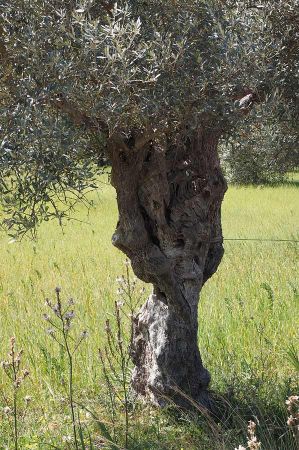 The dove with the olive branch is also a symbol of peace in ancient Christianity. According to the Bible, Noah sent out a dove after the flood. She returned with an olive branch in her beak (Gen 8:11 EU): the earth was green again, life was back. Jesus communed with God between olive trees in the Garden of Gethsemane shortly before his crucifixion (Mt 26:36-46 EU). Paul illustrated the relationship between paganism and Judaism with a wild and a noble olive tree (Rom 11:13-24 EU).
The dove with the olive branch is also a symbol of peace in ancient Christianity. According to the Bible, Noah sent out a dove after the flood. She returned with an olive branch in her beak (Gen 8:11 EU): the earth was green again, life was back. Jesus communed with God between olive trees in the Garden of Gethsemane shortly before his crucifixion (Mt 26:36-46 EU). Paul illustrated the relationship between paganism and Judaism with a wild and a noble olive tree (Rom 11:13-24 EU).
In the early Byzantine period, the export of olive oil was the economic basis for its heyday from the 4th century onwards, as the olive tree grew in all areas around the Mediterranean and partly also around the Black Sea when extreme climatic conditions did not occur. It can endure extreme heat, but suffers easily from frost in cold winters, which threatens not only the harvest of individual years but the existence of entire plantations. It is therefore also considered a character plant of the Mediterranean flora.
Please read as well:
Old Doganbey Village • Domatia
Mantı - Turkish pasta pockets with yogurt
https://www.alaturka.info/en/life/flora/6334-olive-trees-cultural-historical-examination-of-the-olive-tree#sigProIdbf9f5a1daa
